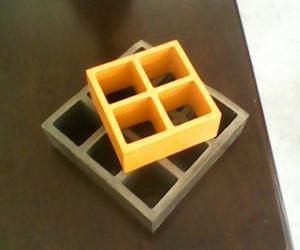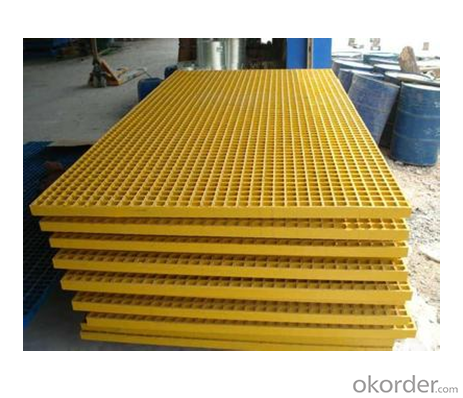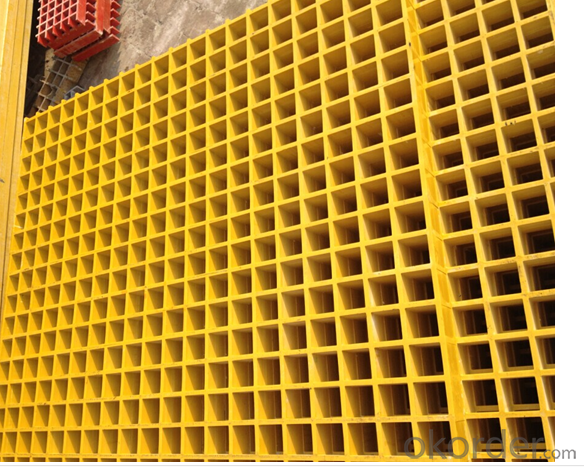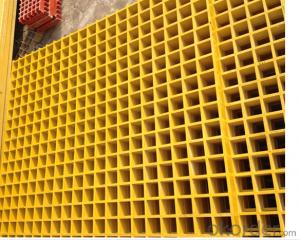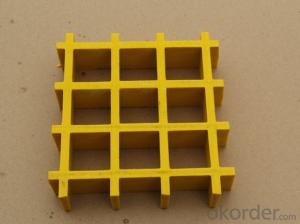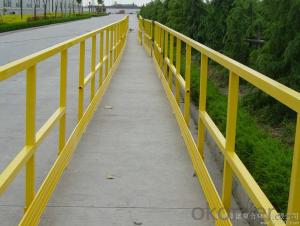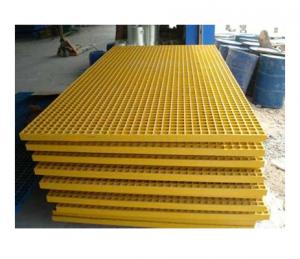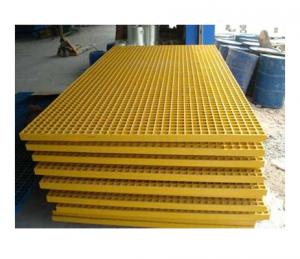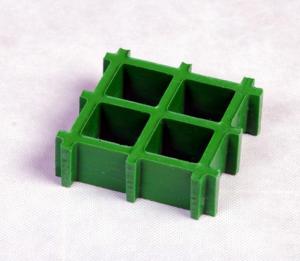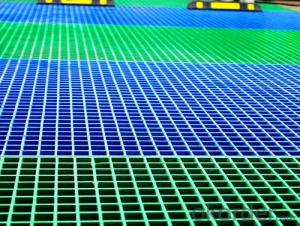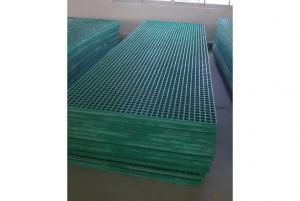FRP Pultrusion Profiles - Best Composites Fiberglass Products FRP Grating with High Quality/Modern Type
- Loading Port:
- China main port
- Payment Terms:
- TT or LC
- Min Order Qty:
- 500 m²
- Supply Capability:
- 100000 m²/month
OKorder Service Pledge
OKorder Financial Service
You Might Also Like
Introduction
FRP Molded Grating is a structural panel which uses high-strength E-Glass roving as reinforcing material, thermosetting resin as matrix and then casted and formed in a special metal mold. It provides properties of light weight, high strength, corrosion resistance, fire resistance and anti-skid. FRP Molded Grating is widely used in oil industry, power engineering, water & waste water treatment, ocean survey as working floor, stair tread, trench cover, etc. and is an ideal loading frame for corrosion circumstances.
Feature
Corrosion Resistance
Fire Resistance
Light Weight & High Strength
Safety & Anti-slip
Electrical Insulating
Aging Resistance
Specification
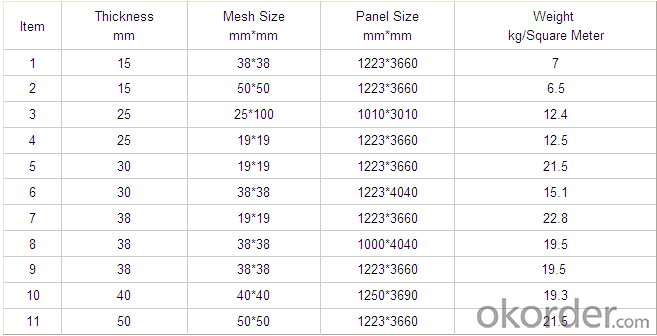
Advantage
coated with prevent aging layer
excellent insulating performance
no maintenance
high strength
long service life
easy installation
Application
Power plants, substation equipment enclosures, antimagnetic, anti-static,to prevent small animals into the equipment failure, as there is electricity facilities and without power interval intervals.
In high voltage electrical equipment for power line work, in order to prevent workers go wrong location, charged interval or near electrically charged equipment to dangerous distance.
Pool railings in sewage treatment industry
- FAQ
1. How's the payment?
Telegraphic Transfer(T/T) or Letter of Credit(L/C)
2. Do You Arrange Shipment?
Yes, dear esteemed customers, for FOB or CIF price, we will arrange shipment for you. For EXW price, clients need to arrange shipment by themselves or their agents.
3. How is the package?
Usually, we arrange the standard out-package for exporting.
FACTORY
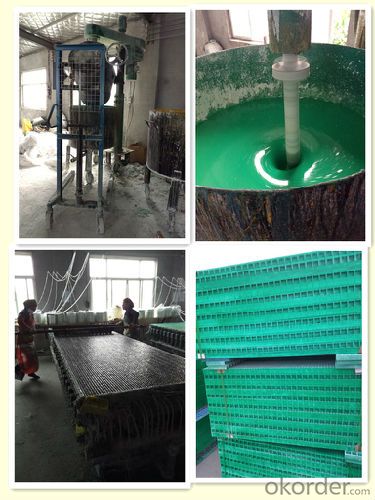
- Q: Can FRP pultrusion profiles be used in the renewable energy and solar power industry?
- Yes, FRP (Fiber Reinforced Polymer) pultrusion profiles can be used in the renewable energy and solar power industry. These profiles offer several advantages such as high strength, durability, corrosion resistance, and lightweight properties, making them suitable for various applications in the industry. FRP pultrusion profiles can be used for structural components, support structures, mounting systems, and other applications in solar panels, wind turbines, wave energy devices, and other renewable energy systems.
- Q: Are FRP pultrusion profiles resistant to biological growth, such as mold or mildew?
- Yes, FRP pultrusion profiles are highly resistant to biological growth, including mold and mildew. The inherent properties of the fiberglass reinforced polymer make it highly durable and immune to the growth of microorganisms. This resistance makes FRP pultrusion profiles ideal for applications in moist or humid environments where mold or mildew growth is common.
- Q: Can FRP pultrusion profiles be customized according to specific requirements?
- Yes, FRP (Fiber Reinforced Polymer) pultrusion profiles can be customized according to specific requirements. Pultrusion is a manufacturing process that involves pulling continuous fibers through a liquid resin bath, then through a heated die to cure the resin and form the desired shape. This process allows for great flexibility in design and customization. The customization options for FRP pultrusion profiles include various dimensions, shapes, colors, and surface finishes. The dimensions can be tailored to meet specific length, width, and thickness requirements. The shapes can range from basic geometries like rectangular or round profiles to more complex designs with custom cross-sections. In terms of color, FRP pultrusion profiles can be pigmented during the manufacturing process to achieve the desired color or can be painted or coated afterwards. This allows for matching specific color requirements or ensuring compatibility with existing structures or products. Furthermore, surface finishes can be customized to achieve desired properties such as increased slip resistance, UV resistance, or fire resistance. Surface treatments like sanding, coating, or adding special additives can be applied to meet specific performance requirements. Overall, FRP pultrusion profiles offer a high level of customization to meet specific project or application needs. They are versatile, lightweight, corrosion-resistant, and have excellent strength-to-weight ratios, making them suitable for various industries such as construction, transportation, infrastructure, and aerospace.
- Q: Can FRP pultrusion profiles be used in the construction of theme park rides?
- Theme park rides can indeed incorporate FRP (Fiber Reinforced Polymer) pultrusion profiles. These profiles possess various advantages that make them suitable for this purpose. First and foremost, FRP pultrusion profiles possess a combination of lightness and strength, rendering them ideal for constructing ride structures that must endure dynamic loads and forces. Their remarkable strength-to-weight ratio enables the creation of intricate, sizable structures capable of supporting the weight of riders and withstanding the forces generated during operation. Moreover, FRP pultrusion profiles exhibit corrosion resistance, a crucial characteristic for theme park rides frequently exposed to outdoor environments, including moisture, chemicals, and UV radiation. This corrosion resistance ensures the durability and safety of the ride structures throughout their lifespan, reducing the need for costly maintenance and repairs. Another advantage of FRP pultrusion profiles lies in their design flexibility. They can be easily shaped and sized to meet the unique requirements of theme park ride designs. This versatility allows for the creation of distinctive, visually appealing ride structures that enhance the overall experience for park visitors. Furthermore, FRP pultrusion profiles possess excellent electrical insulation properties, particularly valuable for rides involving electrical components or systems. This insulation effectively minimizes the risk of electrical hazards, ensuring the safety of riders and operators. In conclusion, FRP pultrusion profiles are an excellent choice for constructing theme park rides due to their lightweight nature, high strength, corrosion resistance, design flexibility, and electrical insulation properties. By incorporating these profiles, safe, durable, and visually captivating ride structures can be developed, enhancing the enjoyment and excitement of theme park visitors.
- Q: How do FRP pultrusion profiles perform in high-wind areas?
- FRP pultrusion profiles are well-suited for high-wind areas due to their inherent strength and durability. These profiles are made from reinforced polymers, typically fiberglass, which provides excellent resistance to wind loads. FRP pultrusion profiles have high stiffness and flexural strength, enabling them to withstand the forces generated by strong winds without significant deformation or failure. Additionally, their corrosion resistance makes them highly suitable for coastal or harsh environments often associated with high-wind areas. Overall, FRP pultrusion profiles perform admirably in high-wind areas, offering reliable and long-lasting structural solutions.
- Q: Are FRP pultrusion profiles resistant to caustic soda?
- Yes, FRP pultrusion profiles are generally resistant to caustic soda. The corrosion-resistant properties of FRP make it suitable for use in environments that involve caustic soda or other aggressive chemicals. However, it is always recommended to evaluate the specific conditions and concentration of the caustic soda to ensure the compatibility of FRP profiles.
- Q: What are the main uses of pultruded glass fiber reinforced plastic extrusions?
- Road transportation shopping malls, the successful use of: highway barrier fence on both sides, road signs, pedestrian overpass, noise barrier, refrigerated vehicle components.
- Q: Can FRP pultrusion profiles be used in the automotive manufacturing industry?
- Yes, FRP pultrusion profiles can be used in the automotive manufacturing industry. They offer several advantages such as high strength-to-weight ratio, corrosion resistance, and design flexibility. These profiles can be used in various automotive applications including body panels, structural components, and interior trim.
- Q: Can FRP pultrusion profiles be used in pedestrian bridges?
- Yes, FRP pultrusion profiles can be used in pedestrian bridges. FRP (Fiber Reinforced Polymer) pultrusion profiles offer several advantages such as high strength-to-weight ratio, corrosion resistance, and durability, making them suitable for pedestrian bridge applications. These profiles can be customized to meet specific design requirements, ensuring the safe and efficient construction of pedestrian bridges.
- Q: Are FRP pultrusion profiles resistant to impact from flying debris?
- Yes, FRP pultrusion profiles are highly resistant to impact from flying debris. Thanks to their reinforced fiberglass construction, these profiles have exceptional strength and durability, making them capable of withstanding significant impact forces without incurring damage.
Send your message to us
FRP Pultrusion Profiles - Best Composites Fiberglass Products FRP Grating with High Quality/Modern Type
- Loading Port:
- China main port
- Payment Terms:
- TT or LC
- Min Order Qty:
- 500 m²
- Supply Capability:
- 100000 m²/month
OKorder Service Pledge
OKorder Financial Service
Similar products
Hot products
Hot Searches
Related keywords
